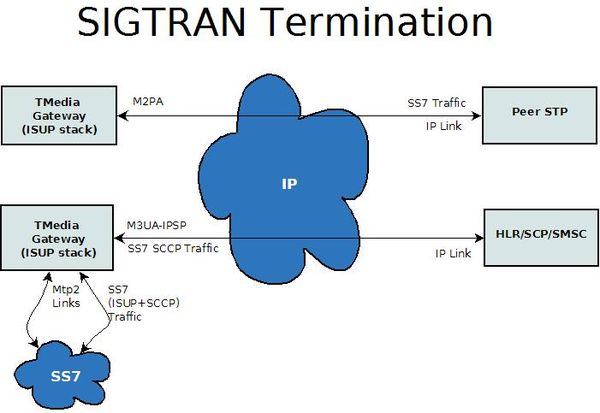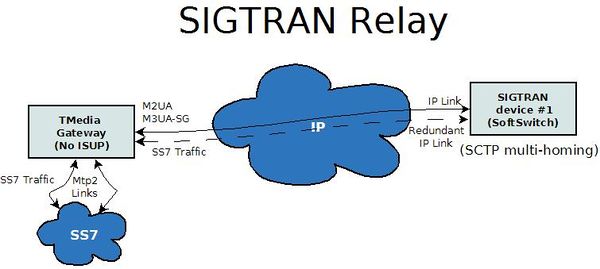SIGTRAN pricing model 2011
| Line 1: | Line 1: | ||
| − | Pricing for TelcoBridges' implementation of [[SIGTRAN]] is based on the concept of termination, with a license required for each termination. An termination corresponds to a link between two unique end-points. An example is provided below. | + | Pricing for TelcoBridges' implementation of [[SIGTRAN]] is based on the concept of termination, with a license required for each termination. An termination corresponds to a link between two unique end-points. An example is provided below. |
| + | [[Image:Sigtran_Termination.jpeg|600px]] | ||
| − | + | In this example, a single TMedia is connected to two other SIGTRAN peers. Each connected stream corresponds to an 'termination'. These are identified as Termination #1 and Termination #2. A single Termination can be multi-homed or not. The SIGTRAN termination in this context is used to receive SS7 signaling on the gateway for ISUP processing. | |
| − | + | [[Image:Sigtran_Relay.jpeg|600px]] | |
| − | + | In this example, a single TMedia is connected to one SIGTRAN peers, a soft switch in this case. In this context, SIGTRAN is used to RELAY the SS7 (MTP2) to the peer using either M2UA or M3UA. There is no ISUP processing on the gateway itself. | |
| + | <br> | ||
| − | == Other details == | + | == Other details == |
| − | *TelcoBridges' pricing model for SIGTRAN does not distinguish between [[M2PA]], [[M2UA]], or [[M3UA]]. All three of these protocols are included in the association license. | + | |
| − | **Due to network design considerations specific to the use of M3UA, it may be necessary to purchase additional M3UA associations for a given pair of endpoints. | + | *TelcoBridges' pricing model for SIGTRAN does not distinguish between [[M2PA]], [[M2UA]], or [[M3UA]]. All three of these protocols are included in the association license. |
| + | **Due to network design considerations specific to the use of M3UA, it may be necessary to purchase additional M3UA associations for a given pair of endpoints. | ||
*The SIGTRAN pricing model does not feature any restrictions on the number of messages or transactions per second. Users are only limited in their use of SIGTRAN by the capacity of the underlying IP link and the telecommunications hardware used in the system. Increasing the capacity of the IP link or the hardware will enable the user to achieve higher message counts per second without requiring additional SIGTRAN associations. | *The SIGTRAN pricing model does not feature any restrictions on the number of messages or transactions per second. Users are only limited in their use of SIGTRAN by the capacity of the underlying IP link and the telecommunications hardware used in the system. Increasing the capacity of the IP link or the hardware will enable the user to achieve higher message counts per second without requiring additional SIGTRAN associations. | ||
| + | <br> | ||
| + | |||
| + | == References == | ||
| − | |||
*[[SIGTRAN]] | *[[SIGTRAN]] | ||
Revision as of 11:57, 14 November 2011
Pricing for TelcoBridges' implementation of SIGTRAN is based on the concept of termination, with a license required for each termination. An termination corresponds to a link between two unique end-points. An example is provided below.
In this example, a single TMedia is connected to two other SIGTRAN peers. Each connected stream corresponds to an 'termination'. These are identified as Termination #1 and Termination #2. A single Termination can be multi-homed or not. The SIGTRAN termination in this context is used to receive SS7 signaling on the gateway for ISUP processing.
In this example, a single TMedia is connected to one SIGTRAN peers, a soft switch in this case. In this context, SIGTRAN is used to RELAY the SS7 (MTP2) to the peer using either M2UA or M3UA. There is no ISUP processing on the gateway itself.
Other details
- TelcoBridges' pricing model for SIGTRAN does not distinguish between M2PA, M2UA, or M3UA. All three of these protocols are included in the association license.
- Due to network design considerations specific to the use of M3UA, it may be necessary to purchase additional M3UA associations for a given pair of endpoints.
- The SIGTRAN pricing model does not feature any restrictions on the number of messages or transactions per second. Users are only limited in their use of SIGTRAN by the capacity of the underlying IP link and the telecommunications hardware used in the system. Increasing the capacity of the IP link or the hardware will enable the user to achieve higher message counts per second without requiring additional SIGTRAN associations.

